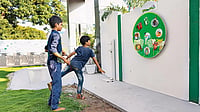Short stories can afford to come with a twist in the end. But epics are fated to contain twists at every turn, at every level of the labyrinth of nested stories. COVID-19 is proving to be one such gigantic and perplexing hall of mirrors: the logic unfolding in a sub-plot at Level 5 can alter the main narrative frame…and then twist again. Immunity is a word that’s been lurking around like a minor character with a walk-on part in the story from the beginning. There was at first that partly naïve optimism in the idea that Indians, on account of exposure to a rich bouquet of pathogens, have a kind of all-purpose ‘native immunity’—a Teflon coating against Covid. As the new coronavirus plugged into India as a collective host, that was soon quietly replaced with a more modest, and perhaps illusorily durable, hypothesis. That if the virus strains were the same as were lacerating Italy, the UK and US, Indians looked at least more immune than the West. Could it have something to do with blood groups and variable vulnerability thereof? Was it the wall-to-wall coverage of BCG vaccination?
The questions seemed valid enough. After all, through Season 1, the India graph had moved at a gentle canter, with a low (official) fatality rate to boot. But as those ominous hoofbeats picked up in May, even that was discarded for a more fragmented picture. Some regions within India looked less (or more) at risk. Over 30 districts witnessed a wide spread, others experienced slower transmission. And seemingly inexplicable variations within that defied a universalising story. It still looks deadliest in Maharashtra, as the state exacts the highest toll. In Delhi, it looks more infectious but not as fatal as in Maharashtra and Gujarat. Kerala has a tremendous recovery rate; no other state has that.
But soon it became clear that one key playfield of variations existed at a still more micro level: not country, not region or ethnicity, but individual. Young Keralites in their 30s were dying in the Gulf, but back home in hilly Ranni, 93-year-old Thomas and his 88-year-old wife Mariyamma tested positive, even got critical and stayed so for days, then happily recovered—defying everything in the COVID 101 handbook about the elderly being at higher risk. By now, this randomness is a leitmotif of the COVID story: you as a patient may have merely experienced an unpleasant fortnight (with your “pizza tasting like cardboard,” as writer Karan Mahajan told The Atlantic), but your neighbour goes to the ICU, perhaps thence to the mortuary. Why? Two axioms stay with us: the new coronavirus has shown an extremely varying propensity and potential to infect, and an equally puzzling unpredictability about who recovers and who does not. And perhaps neither has to do with the virus per se. Some variation in recovery rates could owe to differing healthcare practices and treatment protocols (at state/hospital/country level). But the lens surely needed to be adjusted to another level of magnification—because one key act in this grim drama unfolds inside the individual. This is where immunity comes in.
All other things being equal—age, health, exposure to virus—why does Person A get infected and Person B go unaffected? That’s simply hard-wired innate immunity: a healthy body’s first line of defence against pathogens, an in-built fortification. This invisible armoury of the body is by nature capable of warding off new enemies—so the fact of this being a novel virus wouldn’t matter. The innate system has non-specific barriers that work regardless of who the enemy is—the body-castle’s moat, drawbridge and mortar-fire repel Viking and Mongol alike. By contrast, adaptive (or acquired) immunity is like an active database of prior infections: it invests the body with a pathogen-specific immunological memory. An 85-year-old person’s body thus carries the memory of a childhood measles infection, but is too slow to produce antibodies against a new enemy—hence, more at risk. “This is why children are more protected: their immune systems are simply stronger. That wanes as you age,” says Calcutta paediatrician Dr Aniruddha Maitra. A point of mystery: COVID-19 initially seemed to spare children altogether. Thus the famous ‘double peak’ seen in other infections—older people and children being most vulnerable, healthy adults of median age being the hardiest—was markedly absent here. But as the pandemic spread, even children are seen to be not entirely out of its sway. But regardless of age variation, think of a first layer of armour.
Now, say the enemy penetrates that armour, via a Trojan horse, and you do get infected. Why only a mild flu for X, and ICU for Y? Well, post-infection, innate immunity continues to work, now in collaboration with its brother-in-arms, adaptive immunity: it smells out the foreign invasion, and enlists its ally to produce the ammunition…the antibodies. Inflammation happens, like sirens going off, signalling for reinforcements to rush to the infected site. Usually, this is when you get fever with any flu, before the body recovers. This is where the critical twist in the plot comes. It’s a cataclysmic breakdown of these normal immunity processes—this complex wartime communication machinery—that’s now looming forth frighteningly as a final act. A sudden, little understood crumbling of the fortress. A gasping, shuddering death. The key episode, called a cytokine storm, is now linked to many a Covid fatality. “It’s a centerpiece of COVID-19 pathology,” writes Tufts University immunologist Alexander Poltorak. “The killer is not the virus but the immune response.” Essentially, an excessive reaction or dysregulation of the host’s immune system, akin to what happens with autoimmune disorders. The system goes into hyperactive mode, then goes berserk and launches a stunning mutiny against the body itself—till the whole zeppelin comes flaming down. This happens when immunological agents fail in one key function—recognising self-substances, and exempting them from attack, while it goes for those nasty “non-self” macromolecules (the foreign pathogens).

The realisation that there’s a consistent pattern of Covid fatalities being linked to this inner suicidal drama has led to a reorientation of efforts across the world. That’s why proposed/ongoing studies posted on the US National Library of Health’s ClinicalTrials.gov bear titles that refer to therapeutic strategies targeted at critically ill patients who’ve suffered or are close to an immunological burnout—by modulating or suppressing their immunity processes. A Lancet study called immunosuppression “a double-edged sword” because the body may be still vulnerable to any infection, and leaving it bereft of its armour is risky too. As a focus area, though, it has dawned. But first the macro-level, before we descend the steps.
Are Indians immune?
‘Native immunity’ is actually just a synonym for innate immunity, but let’s twist it to fit us ‘natives’. Have Indians been conferred with an ability to take on all comers of the microscopic variety? Have we acquired a greater immunity by way of familiarity with viruses in general? Would that suffice to thwart a novel and tenacious one like Covid? The idea that prior exposure to other infections can create an all-purpose shield isn’t entirely erroneous. There is such a thing as ‘cross-resistance’, which can work by altering the way receptor sites behave. But India’s climbing numbers do not seem to offer any blanket comfort there. Why?
One reason could be that low nutrition levels enfeeble the delicate web acquired weaves in conjunction with innate. It’s the latter’s signalling apparatus—a complex, multi-function communication grid involving constantly patrolling sentinel called neutrophils, our most abundant White Blood Cells, and proteins called cytokines—that recruit the good guys with the Bofors gun, the B-cells and T-cells. (Roughly, the first produces antibodies that lock onto antigens on the surface of pathogens, and calls upon phagocytes that eat them up; the latter kills infected cells). Micronutrient deficiency leaves this double-barrelled defence fortification starving at all levels. The internet is awash with preprints of studies linking, for instance, Covid morbidity with low Vitamin D levels (severe among the old in Italy, Spain et al). Elina Hypponen, an Australian nutritional and genetic epidemiology professor, offers preliminary support “in theory” for the link, writing: “Nearly all immune cells have Vitamin D receptors (showing the interaction). The active Vitamin D hormone, calcitrol, helps regulate both innate and adaptive immunity. And deficiency is associated with immunity dysregulation.” So, on that front, India fundamentally represents a vulnerable mass of humanity—and it goes beyond vitamin deficiency. (see https://bit.ly/379uA2z).
What about BCG? Can vaccination against bacterial infections even conceivably work against a virus? Well, there’s a new line of theory on ‘trained immunity’—the idea that, say, a vaccine can modify our innate system’s pattern recognition receptors in such a way that they pick up similar antigens on even new enemies (antigens are surface structures on microbial bodies). But it begs further study…. “As of now, there is only correlation,” admits Dr Maitra. And as Lancet warned in another context, “correlation does not equal causation”.
Despite India’s recent surge in cases, some researchers are willing to give a chance to BCG, a mandatory booster for children in India to protect them against meningitis and disseminated TB. “While COVID-19 caused a lot of deaths in Spain, its neighbour, Portugal, witnessed a very low fatality. And Portugal is the only European country where BCG vaccination is still prevalent,” says Dr Sudhir Bhandari, senior professor of medicine at Sawai Man Singh Medical College, Jaipur. “The BCG association, like that of hydroxychloroquine, arose because the early spread of Covid was a reverse image of these two, but there are multiple possible explanations for it without ascribing a causal link,” says Ranchi-based radiologist Dr Manish Kumar.
Many medical professionals anyway dismiss the notion of India (or any other country) collectively having a higher immunity, citing the interplay of several factors that influence transmission and fatality. Dr Yadu Singh, Sydney-based cardiologist, for instance, attributes Australia’s “spectacular” flattening of the curve (a mere 7,227 cases as of June 4, some 6,640 recovered, 102 deaths) to simply “good policies…and civic sense”, adding it has nothing to do with high immunity among Australians. But even if country-wise variations are possible, we’re still in the grip of a story that evokes fear and awe: the perennially unravelling mysteries of Covid, and how your body can itself unravel, a deadly denouement where immunity is the tragic protagonist.
An evolving death
The Covid infection was initially thought to be a merely respiratory phenomenon, affecting only the alveoli in the lungs—and bringing on pneumonia. That’s still the primary effect: the lung’s ACE2 receptors are the most abundant, most strategically placed, most amenable to hosting the virus. But it’s becoming clear that it often causes a “multi-system disorder”, says Dr Maitra—an all-pervasive attack on several fronts. Heart, guts, liver, kidney, brain...all cells can get infected because most organs have ACE2 receptors. A captured heart can go into myocarditis, an inflamed liver produces an enzyme glut. Most benignly, the gut lining; an altered gut flora equilibrium leads to the loss of appetite and/or diarrhoea common to many diseases. The UK officially added the loss of taste and smell as part of Covid symptoms on May 18—either as a presenting symptom, signalling an early onset stage, or independently, without other symptoms. Indeed, isolated anosmia and ageusia are now seen as a tool to screen potential spreaders, for these are often associated with a milder form of the virus—patients “10 times less likely” to go on to be critical. The reasons for anosmia/ageusia are not understood yet. One view is that ACE2 is also present in cortical neurons, making them potential targets. Another is that it’s likely to be a secondary effect—the nervous system, for instance, is dependent on blood oxygen to function properly—rather than a direct infection of the nerves, as in, say, forms of meningitis or encephalitis.
This brings us to another potentially crucial site: blood. It was controversially proposed in a ChemRxiv preprint by two Chinese scholars and then reiterated by Italian pharmacologist Annalisa Chiusolo that the Covid virus manages to plug on to red blood cells, crack open the haemoglobin and release the enclosed iron. This was then linked to all the observed chain of catastrophic effects: anaemia, excess iron choking the kidney; silent hypoxia (from a hindered exchange of oxygen and carbon dioxide) starving all organs, including the brain; thrombosis, with all its usual effects (heart attack, stroke) et al. Blood was also a putative candidate to explain Covid’s rainbow effect: the all-pervasive nature of its attack on the body. The theory is hotly disputed, even if Ebola too famously wrought havoc on blood systems in unexplained ways. The idea that the virus cracks open haemoglobin molecules (haemolysis) may or may not endure. Then where do we take all that stunning variety of symptoms? Well, recent understanding inserts a vital first step: immunity-gone-awry. Once that happens, your body-castle turns into a house of cards and caves in. That’s cause; haemolysis, thrombosis et al are effect (https://bit.ly/3cGOKli).
So the real twist in the plot is when your body starts eating itself. An uncontrolled immunological self-immolation. And it’s cytokines that do the arson. “Small proteins important in immunological processes” and produced by white blood cells are called macrophages, their job is to “trigger inflammation” and “recruit” other immunological elements to fight infection. Why they dysfunction is because Covid manages to “silence” this inflammatory response, and grows in the body in what an Atlantic article called “stealth mode”. When the body realises belatedly that it has been totally besieged, the immune system goes into overdrive: cytokine storm. A mass attack ensues on infected cells. The lungs fill with a sea of dead cells, a kind of biological sludge that leads to organ failure. The blood clots all over, blood vessels leak, BP plummets because of vasodilation, anaemia occurs. Somewhere along this disastrous slope, they start turning on even healthy body cells. Just like any other autoimmune disorder, it’s an aberrant overreaction that some people have. Including, it’s now known, a subset of the children who get infected. Why only they have it is one of the mysteries of science. Thus, from a struggling country down to a self-immolating cell, the view is different at each step down the baoli. And the last step promises a pool of water with no clear reflections.
Vox PoP

Dr Ramanan Laxminarayan
Director, Center for Disease Dynamics, Economics and Policy, Washington
Are we more immune? Does BCG, heat…any of that matter? Does having a younger population?
Younger population, yes. Not the others, of course. There is no difference in immunity, I think the only difference is that we got the epidemic later—India, Pakistan, Bangladesh all got it later. Remember, at one point in the global curve of number of cases, we were at number 39. Today, we’ve caught up…. So there’s no question of us being more immune, it is just how countries managed their lockdown. There is no escaping the virus.


























